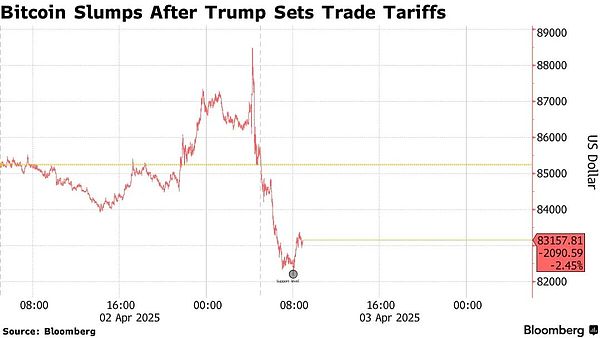
Author: Zhou Ziheng
The "Global Reciprocal Tariff Plan" announced by US President Donald Trump on April 2, 2025 has triggered severe shocks in the financial market. This trade protection covering more than 180 trade protections implement differentiated tariffs according to different economies, of which the EU faces 20% tariffs on automobile and agricultural products, and the 34% tariffs on electronic and mechanical products have brought the total tax rate to 54%, Japan's auto parts tariffs have been raised to 24%, and Southeast Asia's electronic products tariffs are set at 15%. The timetable released by the White House shows that the 10% basic tariff will take effect immediately on April 5, while higher tax rates for specific industries will be implemented on April 9. It is worth noting that this tariff list has specially added strategic materials such as semiconductors and new energy batteries, showing a deep intention to curb the development of science and technology.
The global financial market responded sharply to this, with the European Stoke 50 plunging 4.2%, and the German DAX index hitting the largest single-day decline this year; in the Asian market, the Nikkei 225 index closed down 3.7%, the South Korean KOSPI index fell 5.1%, and Samsung Electronics' stock price plummeted 7.2%; the US S&P 500 futures decline expanded to 3.4%, and multinational companies such as Apple and Tesla fell more than 5% before the market. JPMorgan Chase’s latest research report shows that if countries take reciprocal retaliation measures, it may lead to a shrinking of global trade volume by 12%-15%, the growth rate of US GDP fell by 1-1.2 percentage points, and the inflation rate rose by an additional 1.3 percentage points.
The cryptocurrency market encountered the most tragic selling wave in 2025. Bitcoin crashed from a high of US$88,000 to US$82,000, and a 6.8% decline swallowed up the gains in the past three months; Ethereum fell below the key support of US$4,500, a drop of 9.2%, and Solana's market value evaporated by US$2.3 billion in a single day; the total amount of liquidated shares in the derivatives market reached US$1.87 billion, a record high this year. The flow of funds showed obvious differentiation, with cryptocurrency ETFs having a net outflow of US$8.7 billion in a single day, Coinbase's stock price plummeted 11% after the session, while gold spot broke through the historical high of US$3,160, and U.S. Treasury yields plummeted by 25 basis points.
The current cryptocurrency market has a cognitive split in attributes, and its correlation with the Nasdaq index has risen to 0.74, and institutional investors still classify it as a "high-risk technology asset"; the transmission chain shows that tariffs lead to rising production costs and bring inflationary pressure, which in turn affects currency tightening expectations. The Federal Reserve may postpone interest rate cuts, which will directly affect market liquidity expectations; although some investors regard Bitcoin as "digital gold", its correlation with traditional safe-haven assets during geopolitical conflicts is only 0.32, and the probability of a simultaneous decline with US stocks during liquidity crisis is as high as 81%.
The market is facing multiple risk tests. If Bitcoin falls below the support level of US$78,500 in the short term, it may trigger a series of quantitative trading closing positions. The "crypto regulatory summit" planned by the US SEC may introduce new stablecoin regulations; in the medium term, the EU has formulated a retaliatory tariff list of US$30 billion, and Apple announced that it will accelerate the transfer of production capacity in Southeast Asia; in terms of long-term structural changes, the G20 may establish unified regulatory standards, and BlackRock report shows that 58% of institutions plan to reduce the allocation ratio of crypto assets.
Investment strategies need to be adjusted according to risk preferences. Conservative investors can increase their positions of gold ETFs and 10-year U.S. bonds with 20%-30% positions. Balanced investors recommend maintaining the allocation of core crypto assets no more than 15% of total assets. Advantageous investors can pay attention to the oversold opportunities of the Layer2 track but need to set a 10%-15% stop loss line. Standard Chartered's "dual-track scenario forecast" shows that Bitcoin's Q3 is expected to hit $120,000 in the optimistic scenario of the Federal Reserve's interest rate cut in May, and the support level of $65,000 may fall in the continued pessimistic scenario of the trade war.
The next few key time nodes are worth paying close attention to. The US CPI data was released on April 15, the Federal Reserve interest rate meeting on May 2, and the G20 Special Meeting of Trade Ministers on June 18. This market turmoil reveals that cryptocurrencies have not yet completed their identity transformation from "risk assets" to "help-haven assets". The independence of digital assets is facing severe tests in the context of the globalization ebb. The macro impact coefficient on the crypto market has risen from 0.32 in 2019 to 0.68 at present. As the situation develops, the direction of the market will depend on the interaction of multiple factors such as trade evolution, response measures from countries, and the Federal Reserve's currency adjustment.











